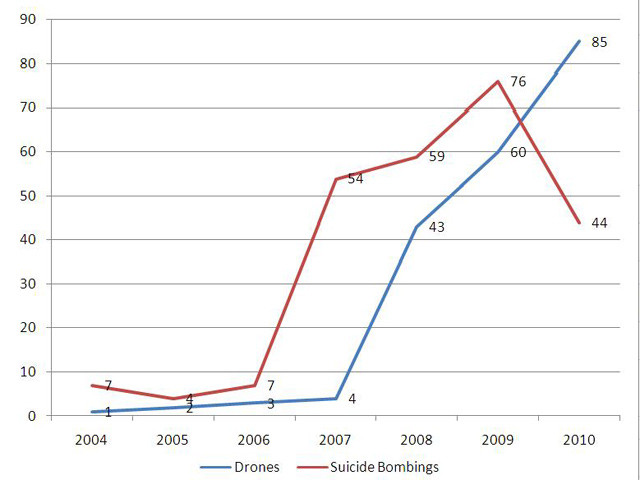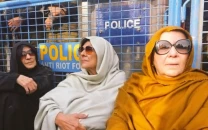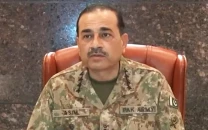Drone attacks hit all-time high
Twentieth drone strike this month takes place in North Waziristan.

According to researcher Dr Zeeshanul Hasan Usmani, who monitors drone and suicide attacks in the country, there have been a total of 198 drone attacks since the first hit on June 18, 2004 in South Waziristan Agency. The attack killed five people, including Taliban commander Nek Mohmmad. More than 2,100 people have been killed so far, including 36 high-profile militants, he said.
Since US President Barack Obama came into office, there have been 143 drone attacks, with about 58 strikes in 2009 (after January 20) and 85 in 2010.
Usmani’s data has been gathered through media reports. His way of counting the number of casualties is different from that of Western organisations. Usmani said: “I use the opposite approach from them. When the US calls all deaths in a drone attack as that of ‘militants’, I call them ‘civilians,’ until it is clearly specified which terrorist organisation the dead belonged to. Furthermore, I count everyone below the age of 12 as civilians, and all women and children as civilians too.”
According to Usmani, a total of 2,063 civilians have been killed and 514 people have suffered injuries. “To kill one terrorist you have to kill 57 Pakistanis,” he added.
For the last three years, the largest numbers of drone attacks have taken place in September. In 2008, 10 drone attacks occurred in September, which was the highest in a month for that year. Then in 2009, eight strikes took place in the tribal areas in September, which was the highest for that year. As of yet, 20 drone attacks have taken place in September 2010, which has broken the previous record of 14 strikes in January 2010.
Fata MNA Jawad Hussain said that it is possible that the number of attacks increase in September because “it evokes the memory of 9/11 in the US forces and they take out their revenge on our people in the tribal areas.”
Usmani said that if someone is walking in the tribal areas on a weekend instead of a Monday morning, he will have five times more chances of getting killed in a drone attack. And the chances of getting killed double if the person is out on a Wednesday. “There are nine per cent chances of an attack on Monday compared with 45 per cent on weekends and 20 per cent on Wednesdays,” he said. Also, almost 90 per cent of the attacks occur between 2am and 8am.
According to Usmani’s data “the number of drone attacks and suicide bombings are directly proportional. The data shows that the more drone attacks occur, the more suicide blasts there are in the country.”
All drone strikes this month have been in Waziristan. Out of the 20 strikes, 19 have been in North Waziristan and only one in South Waziristan. The Pakistan Army had launched a military operation against militants in the south, while it reportedly refused to venture into the north because the military was already stretched beyond its limits.
“Militants, including Arabs and top Pakistani Taliban leadership from all over the tribal areas, especially those in South Waziristan have taken shelter in North Waziristan,” said analyst Zahid Hussain. “Also the Haqqani network of militants has a stronghold in North Waziristan. In fact it is clear that the north has the most concentration of militants.”
Hussain said the government and armed forces are hand in glove with the strategy of using CIA operated drones. “There is absolutely no doubt that Pakistan is complicit,” he said.
He warns that drone attacks are “not an effective long-term strategy.” This is an ideological and political war that cannot be won through the use of drones. Each time it is proclaimed that a top militant has been killed, another militant comes up to take up the leadership. Look how after Baituallah’s death, Hakimullah took over the reins of the Pakistani Taliban and the militants are as deadly as ever.”
An MNA from North Waziristan, Mohammad Kamran Khan, said that although there is no question that the Haqqani network, Arab fighters and other militants have a stronghold in his hometown, “the truth is that for each drone attack, we are creating 100 new militants.”
Khan said the people of his area, most of whom have nothing to do with militancy, are terrified of drones. “I recently visited North Waziristan during Eid. People were angry with me for the large number of civilians killed in these attacks. They were angry with the Pakistan government and our armed forces for not doing anything to put a halt to these attacks. Also, their hatred towards America was at an all-time high.”
Another parliamentarian, Noorul Haq Qadri, said it should be left to the Pakistan forces to deal with the militants. “The lava of anger and hatred is flowing in the tribal areas,” he warned. “Clearly, the drone attack strategy is not winning people over. It is only increasing hatred against the US and now more people are taking up arms.”
ISPR spokesperson Major-General Athar Abbas acknowledged that drone attacks “harm more than they help. They are counterproductive,” he said.
Published in The Express Tribune, September 27th, 2010.



















COMMENTS
Comments are moderated and generally will be posted if they are on-topic and not abusive.
For more information, please see our Comments FAQ